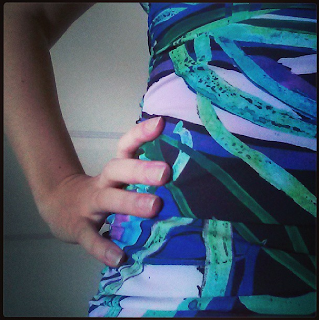My cousin Neal got married to his lovely wife Helena in November of 2013. The wedding was on the beach on Stradbroke Island in Queensland, and it was absolutely beautiful (see above), a really lovely day to be part of. If I'm remembering correctly they had requested/suggested a quilt as a wedding gift from my Gran. Granny and I decided that I could help with the quilt, so we started working on it when she was visiting Victoria for the first few months of last year.

Granny wanted to make a medallion quilt design, so we sat down with some paper, a ruler and pencil and experimented with a few designs. I had learnt with the previous the medallion style quilt I've made that it's a lot easier to design the quilt if you have a base unit of measure that each border is a multiple of. We tried a few variations and different borders and such, and eventually settled on the design you can see in the photos, involving quarter square triangles, squares, flying geese, applique and plain fabric borders.

Granny knew she wanted to include turquoise as one of the main colours (the main colour chosen at the wedding, for the decorations, bridesmaid's dresses and groomsmen's ties), and also wanted it to go well in their bedroom, which has a royal blue wall and a lovely painting on the wall with some orange in it (which isn't the room pictured here). From here we had our main colour scheme so went hunting for fabric.

All the fabric was bought at GJs Discount Fabrics, and we tried to pick a range of colours, from pale to bright to dark, and a range of print sizes, from large prints to small prints to solid colours. I particularly like the addition of the orange with the blue and turquoise, I think it's made for a really fresh looking quilt.
One of the fabrics we chose had a larger floral motif, that Granny decided to applique onto the large turquoise border, along with some bias strips and similarly cut out leaves.

Granny did the majority of the piecing of the quilt, although I helped with a little bit of it and with some of the cutting. For the quarter square triangles in the middle we used this method and for the flying geese we used this method.

Once the piecing was finished, I was in charge of quilting, and I ended up doing a combination of free motion quilting and straight line quilting, varying the quilting design to suit each border. We discussed a few different options, and quickly settled on stippling on the quarter square triangles in the centre and the border of squares. It took a little more thought for the other sections.

Darren made the fantastic suggestion of cross-hatching the background of the applique border, so I stitched all the way around the edge of the applique, and then marked the cross hatch lines at 1" intervals, first doing one direction then the other. There was quite a bit of quilt manhandling required to do the cross hatching, as I went back and forth along the lines but I am thrilled with the outcome so glad to have bothered. Having spent my time basting properly and using my walking foot, I didn't have any issues with puckering of the fabric when I was doing the second pass of the crosshatching, which I had been a little concerned about.

In the end, after trying a few different options (including in this baby quilt) I decided to just stitch in the ditch of the flying geese. I just went back and forth in a zig-zag along each side of the geese to reduce the rotation required of the quilt.

For the larger blue outer border I had decided very early on that I would just do concentric squares around the border, and when deciding how far apart to do them I decided to make them progressively further apart as they reached the edge of the quilt.

The quilt is finished with some orange binding, and it has a turquoise backing (from the backing section at GJs so we didn't have to piece the back, hurrah!)

A big project, and I'm absolutely thrilled with how it turned out. I was secretly hoping that Neal and Helena wouldn't like the quilt and I'd be able to claim it. Sadly that wasn't the case, so it has a happy new home with them.

.jpg)











































